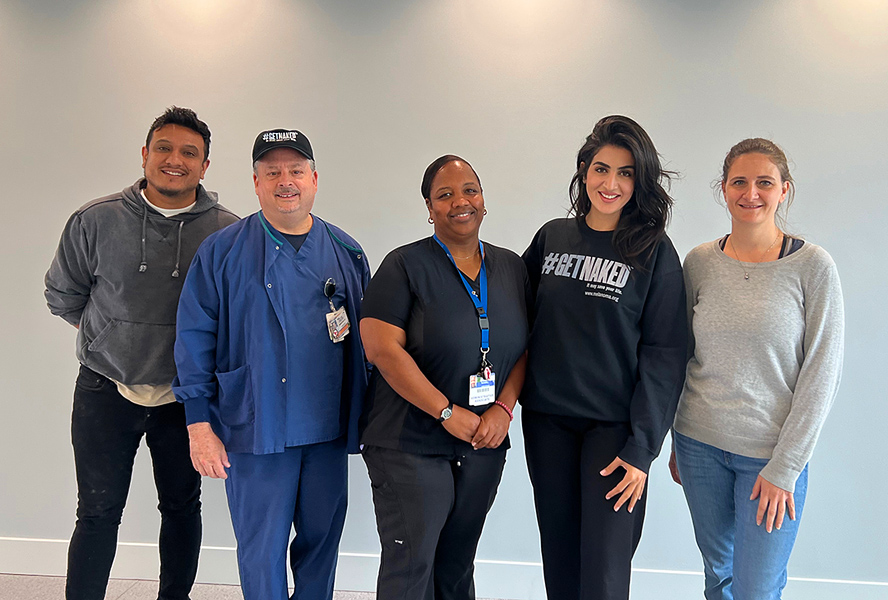
Taking care of your skin goes beyond just vanity; it’s about preserving your health, well-being, and potentially saving your life.
This month is a reminder of the urgent need to educate ourselves and others about the risks and warning signs of melanoma, an aggressive disease. By increasing awareness, we can empower individuals to take proactive steps towards prevention, early detection, and seeking timely medical attention.
To raise awareness, the Melanoma Research Foundation’s #GetNaked campaign encourages individuals to be vigilant about their skin health. Encouraging people to “get naked,” the campaign emphasizes the importance of performing thorough self-examinations, including areas that are typically covered by clothing. Through regular skin exams, look for any suspicious moles or changes. The campaign wishes to empower individuals to proactively take steps in detecting melanoma at its’ early stages.
Melanoma is a type of skin cancer that arises from the pigment-producing cells (melanocytes) in the skin.
– Melody Simanian, PA
As a healthcare provider for patients with melanoma…
I find myself overwhelmed with emotions during Melanoma Awareness Month. It’s a time when we come together to shed light on the gravity of melanoma, a disease that can steal lives far too soon. Life often gets busy, and it’s easy to overlook our own well-being amid our daily responsibilities. Take a moment to remind yourself of the importance of self-care and making your health a priority.
Routine skin exams are a simple, yet crucial step, in staying vigilant and catching any potential risks before they escalate. Regular skin checks, conducted by dermatologists, healthcare professionals, or through self-examinations, called the ABCDE’s, can lead to the identification of suspicious moles or lesions at their earliest stages. The beauty of a routine skin exam lies in the ability to empower ourselves through early detection. Detecting skin irregularities early can greatly increase the chances of successful treatment and recovery. Early detection is the key that can unlock a world of possibilities.
Remember, even the smallest change can be significant.
– Melody Simanian, PA
Here are some key things to look for during a skin check:
- Asymmetry: Look out of irregularly shaped moles.
- Border irregularity: Examine the edges of moles or lesions for uneven or scalloped borders instead of smooth, regular edges.
- Color variation: Look for moles or lesions with multiple colors or shades, such as different shades of brown, black, blue, red, or white.
- Diameter: Pay attention to the size of moles or lesions.
- Evolution: Observe any changes in moles or lesions over time. This includes changes in size, shape, color, elevation, or the development of symptoms such as itching, bleeding, or crusting.
- New or unusual growths: Take note of any new moles, lesions, or growths on the skin, especially those that stand out in terms of appearance or differ from existing moles.
- Location: Certain areas may be more prone to melanoma, so pay close attention to the face, neck, scalp, hands, and feet. However, melanoma can occur anywhere on the body, including areas not exposed to the sun.
- Gender: Women tend to get melanoma on the legs and men on the trunk. Melanoma can occur on the scalp, even with a full set of hair.
- Family and personal history: Consider your genetics and if you have a personal and family history of melanoma. Individuals with a personal or family history of melanoma are at higher risk and may require closer monitoring.
Saint John’s Cancer Institute’s Melanoma Program
I’ve been fortunate enough to work at the Cancer Center at Providence Saint John’s Hospital with Dr. Richard Essner, one of the most talented surgical oncologists and researchers I have come to know. As a practicing PA, it’s heartbreaking to see your patient with metastatic melanoma. However, amidst the difficult cases, one of the most rewarding aspects of my career has been the opportunity to detect melanoma at an early stage. Witnessing the challenges faced by my patients and their families in these advanced stages has driven my dedication to promoting early detection.
We guide our patients through the entire process.
– Melody Simanian, PA
The moment a patient walks into our clinic, they are apprehensive, scared, and uncertain of what comes next. When a patient presents with a suspicious mole or skin lesion, a mix of emotions fills the room. As a trained healthcare provider, my heart races with concern and hope. Knowing that timely intervention can significantly impact the patient’s long-term outcome fuels my determination to provide the best care possible.
After identifying a suspicious lesion, our team moves forward with diagnostic procedures. Whether it’s performing a biopsy or ordering imaging studies, every step is taken with the patient’s well-being in mind. It is during this process that we strive to maintain open lines of communication by explaining each step, addressing concerns, and providing support to alleviate any anxiety. When a diagnosis of melanoma is confirmed, no matter what stage it is, we provide our patients with treatment options. We know that the prognosis is often favorable, and the chances of a successful treatment and recovery are significantly improved when melanoma is found early. Early-stage melanoma allows for less invasive surgical procedures, potentially avoiding the need for extensive lymph node dissections, or additional treatments.
In the face of melanoma, hope is not just a word; it’s the belief that breakthroughs in research and treatment options are continuously unfolding. It’s the unwavering dedication of healthcare professionals, researchers, and organizations who work tirelessly to find a cure. Most importantly, it’s the resilience and fighting spirit within each one of us.
Together, let’s encourage everyone to prioritize these checks, as they can truly be lifesaving.
Happy Melanoma Awareness Month.
With heartfelt gratitude,

